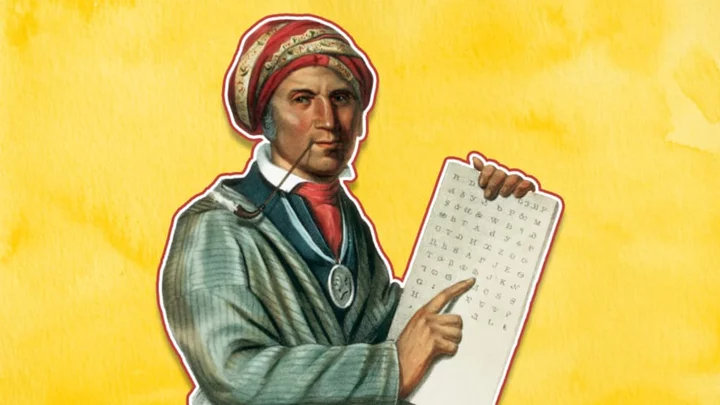Sequoyah was fascinated by books and letters, enchanted by the way people could divine meaning from ink-stained scribbles on a written page. Born circa the 1760s in what is now Tennessee and trained as a silversmith and blacksmith, the Cherokee man was said (according to legend) to have never learned how to read or write in English—but he always knew that literacy and power were intertwined.
The Power of the Written Word
During most of Sequoyah’s lifetime, the Cherokee language was entirely oral. According to the Manataka American Indian Council, a written language may have existed centuries earlier, but the script was supposedly lost as the tribe journeyed east across the continent. Sometime around 1809, Sequoyah began working on a new system to put the Cherokee language back on the page. He believed that, by inventing an alphabet, the Cherokee could share and save the stories that made their way of life unique.
At first, some Cherokee disliked Sequoyah’s idea. White people were encroaching further on their land and culture, and they were resistant to anything that resembled assimilation. Some skeptics saw Sequoyah’s attempts to create a written language as just another example of the tribe becoming more like the oncoming white settlers—in other words, another example of the tribe losing a grip on its culture and autonomy.
Sequoyah, however, saw it differently: Rather than destroy his culture, he saw the written word as a way to save it. According to Britannica, he became convinced that the secret of white people’s growing power was directly tied to their use of written language, which he believed was far more effective than collective memories or word-of-mouth. In the words of Sequoyah, “The white man is no magician.” If they could do it, so could he.
Sequoyah became further convinced of this in 1813, after he helped the U.S. Army fight the Creek War in Georgia. For months, he watched soldiers send letters to their families and saw war officers deliver important commands in written form. He found the capability to communicate across space and time profoundly important.
Developing the Cherokee Alphabet
Sequoyah’s first attempt to develop a written language, however, was relatively crude by comparison. He tried to invent a logographic system, designing a unique character for every word, but quickly realized he was creating too much unnecessary work for himself. (According to historian April Summit’s book, Sequoyah and the Invention of the Cherokee Alphabet, his wife may have attempted to burn an early version of his alphabet, calling it witchcraft.)
So Sequoyah started anew, this time constructing his language from letters he found in the Latin, Greek, and Cyrillic alphabets, as well as with some Arabic numerals.
Sequoyah became more reclusive and obsessive, spending hour upon hour working on his alphabet. According to the official website of the Cherokee Nation, people outside his family began whispering that he was meddling with sorcery. By 1821, Sequoyah was too busy to pay the gossip any mind: He was teaching his 6 year old daughter, Ayokeh, how to use the system.
As one story goes, Sequoyah was eventually charged with witchcraft and brought to trial before a town chief, who tested Sequoyah’s claims by separating him and his daughter and asking them to communicate through their so-called writing system. By the trial’s end, everybody involved was convinced that Sequoyah was telling the truth—the symbols truly were a distillation of Cherokee speech. Rather than punish Sequoyah, the officials asked him a question: Can you teach us how to read?
Once accepted by the Cherokee, Sequoyah’s 86 character alphabet—which is technically called a “syllabary”—was widely studied. (According to a number of sources, a redundant letter was eliminated at some point, reducing the number of characters to 85.) Thousands of people would learn how to read and write within just a few years, with many Cherokee communities becoming more literate than the surrounding white populations. It wasn’t long before the Cherokee language began appearing in books and newspapers: First published in 1828, The Cherokee Phoenix was the first Native American newspaper printed in the United States.
Sam Houston, the eventual governor of Texas, admired Sequoyah’s achievement and reportedly told him, “Your invention of the alphabet is worth more to your people than two bags full of gold in the hands of every Cherokee.” Today, while the Cherokee language is now considered endangered by UNESCO, Sequoyah’s system remains a landmark innovation—and a source of hope for the future.
You can visit Sequoyah’s one-room log cabin, which still stands in Sallisaw, Oklahoma. Not only is it listed on the National Register of Historic Places, it has also been designated a Literary Landmark.
A version of this story ran in 2018; it has been updated for 2023.
This article was originally published on www.mentalfloss.com as Sequoyah: The Man Who Saved the Cherokee Language.









